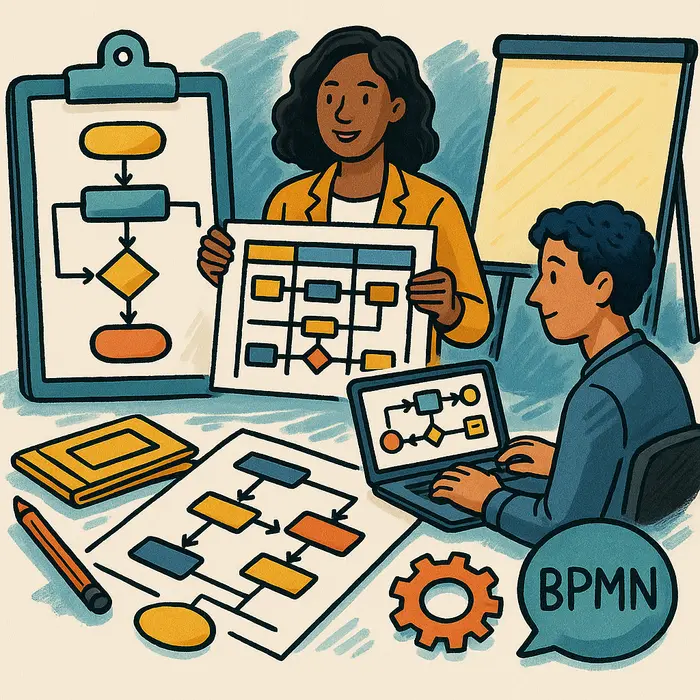Business processes are the lifeblood of every organization. Whether you’re onboarding customers, managing invoices, or fulfilling orders, how well your processes flow can make or break efficiency.
But here’s the thing—most people don’t really understand their own processes until they see them mapped out.
That’s where process mapping comes in. And as a business analyst or improvement-minded manager, you have a few powerful tools at your disposal: flowcharts, swimlanes, and BPMN (Business Process Model and Notation).
Each serves a different purpose, and choosing the right one can make your analysis sharper, your communication clearer, and your improvements more actionable.
What Is Process Mapping?
Process mapping is a visual way to represent how a process works—step-by-step. It shows the sequence of activities, decisions, inputs, outputs, and who is responsible.
Done well, it helps you:
Understand current workflows
Spot inefficiencies, delays, or gaps
Align stakeholders on how things actually happen
Design better processes for the future
** The 3 Most Common Process Mapping Tools**
1. Basic Flowcharts
What it is:
A simple, linear diagram showing the sequence of steps in a process.
Best for:
High-level overviews
Simple, small processes
Early-stage understanding
Components:
Rectangles: Actions/steps
Diamonds: Decision points
Arrows: Flow direction
Ovals: Start/End points
Example:
A customer order process:
[Start] → [Receive Order] → [Check Inventory] → [In Stock?] → [Ship Product] → [End]
Pros:
Easy to create and read
Great for brainstorming and quick alignment
Cons:
Doesn’t show who does what
Can get messy with complex processes
2. Swimlane Diagrams
What it is:
A flowchart that divides the process into “lanes,” each representing a person, role, or department.
Best for:
Clarifying roles and responsibilities
Cross-functional processes
Highlighting handoffs and delays
Components:
Same shapes as a flowchart
Horizontal or vertical lanes
Each step placed in the lane of the actor responsible
Example:
Order process with swimlanes:
Sales lane: Receive order
Warehouse lane: Check inventory, Ship product
Customer Service lane: Notify delays
Pros:
Highlights responsibility clearly
Identifies bottlenecks and unnecessary handoffs
Cons:
- Becomes hard to read with many lanes or loops
3. BPMN (Business Process Model and Notation)
What it is:
A standardized, detailed modeling language used to define complex business processes.
Best for:
Enterprise-level process documentation
Workflow automation
Handing off specs to developers or system architects
Components:
Pools and Lanes: Represent participants
Activities: Tasks and sub-processes
Gateways: Decisions and branches
Events: Triggers and results (start, intermediate, end)
Artifacts: Notes, data, messages
Example:
A BPMN diagram might show:
Message events
Timer events
Parallel tasks
Error handling flows
Pros:
Rich, precise, standardized
Excellent for automation or system integration
Cons:
Steeper learning curve
Can intimidate non-technical stakeholders
When to Use Which Tool?
| Use Case | Recommended Tool |
|---|---|
| Quick overview or brainstorming | Basic Flowchart |
| Clarifying responsibilities or handoffs | Swimlane Diagram |
| Detailed, structured modeling for automation or system design | BPMN |
Tools for Process Mapping
You don’t need fancy software to get started. Here are options for each level:
Whiteboard or Sticky Notes: Great for workshops
Draw.io (diagrams.net): Free and flexible
Lucidchart or Miro: Easy drag-and-drop with team collaboration
Bizagi Modeler or Signavio: BPMN-focused platforms for more advanced modeling
Example in Practice: Mapping a Leave Request Process
Flowchart View:
Start → Submit Request → Manager Approves? → [Yes] → HR Processes → Notify Employee → End↓[No] → Notify Rejection → End
Swimlane View:
Employee: Submit request
Manager: Review/Approve
HR: Process request, notify employee
BPMN View:
Start event: Request submitted
User task: Manager review
Exclusive gateway: Approved?
Service task: HR processing
End events: Approved or rejected notification sent
Best Practices for Process Mapping
Define scope first: What’s the start and end? What’s included?
Start simple: Don’t overcomplicate in early drafts.
Use consistent symbols: Especially if you’re sharing across teams.
Validate with real users: Walk through the map with those doing the work.
Look for improvement opportunities:
Long handoffs?
Redundant steps?
Unclear decisions?
Final Takeaway
You don’t need to be a BPMN expert to get value from process mapping. Start simple, choose the right tool for the task, and focus on clarity.
Whether you use a basic flowchart, a swimlane diagram, or a full BPMN model, mapping your processes will help your team:
Understand how things really work
Spot inefficiencies
Improve collaboration
Design smarter systems
“If you can’t see it, you can’t improve it.”
So grab a pen—or your favorite mapping tool—and start drawing clarity into your workflows.
